Effect of the Reynolds Number and Clearance Flow on the Aerodynamic Characteristics of a New Variable Inlet Guide Vane
Abstract
:1. Introduction
2. Airfoil Samples and Evaluation
2.1. Research Samples
2.2. Numerical Method and Verification
3. Two-Dimensional Research: Airfoils
3.1. Loss Coefficient and Deviation
3.2. Flow Mechanism: Pattern of Transition and Separation
- Design Point ()
- Maximum incidence ()
- LE separation. In the high Reynolds number range (), a laminar separation region is formed in the LE region due to the adverse pressure gradient behind the LE suction spike. Although the reduction in the Reynolds number in this phase is considerable (), the length of the LE separation only shows a slight increase of 2.4% in chord length, so the growth rate of the loss coefficient is low in this phase (Figure 10a).
- LE and secondary separation. In the intermediate Reynolds number range (), a secondary separation region appears at about 15% chord location, on the suction surface (Figure 10a). The boundary-layer separation region identified by the laminar separation criteria, i.e., shape factor (Figure 11a), fits well with the range identified by the skin friction coefficient (Figure 11b), which indicates that it is a laminar separation. In this phase, with the reduction of , the LE laminar separation region decreases 1.4% in chord length; meanwhile, the secondary laminar separation region extends 6.3% in chord length, so the airfoil loss coefficient keep increasing with a rate higher than phase I.
- Secondary separation. In the low Reynolds number range (), it is found the LE laminar separation disappears. This is because the relative thickness of boundary layer () will be larger at low Reynolds number and this changed the effective aerodynamic shape of the airfoil (Figure 12a), which results in lower peak Mach number (Figure 10b). The decreased peak Mach number reduces the strength of subsequent adverse pressure gradient, and then the LE laminar separation disappears. As shown in Figure 10a, with the reduction of Reynolds number from , the separation inception point remains nearly constant, but the re-attachment point moves towards downstream from to , leading to a rapid extension of the separation region. In addition, the strength and height of the boundary-layer velocity loss is also significantly increased (comparing SP3 with SP4 in Figure 12b). These two factors (the increase in the length and height of the laminar separation region) causes the high growth of the loss coefficient in this phase (Figure 10a).
4. Three-Dimensional Research: VIGV for High Pressure Compressor
4.1. Methodology
4.2. Reynolds Number Effect in Three-Dimensional VIGV
4.3. Impact of Endwall Leakage Flow
5. Conclusions
- With the reduction in Reynolds number , the airfoil loss coefficient and deviation first increase slightly and then enter a high growth rate in the low range. For the two researched airfoils, the initial Reynolds number to the rapid performance degradation is for the design point and for the high incidence and max incidence.
- For VIGV airfoils at the design point, in the high Reynolds number range, the antagonism between the reduction in the turbulent portion length and the thickening of the laminar portion makes the airfoil performance insensitive to the Reynolds number. Once the Reynolds number reduces to a certain value, the laminar separation bubble appears on the rear portion of the suction surface and extends rapidly because of the downstream migration of the re-attachment point, which leads to the steep increase in loss coefficient.
- For VIGV airfoils at maximum incidence, the flow separation pattern is not the same for the two researched airfoils. However, for both airfoils, the rapid increase in the loss coefficient at a low Reynolds number is caused by the increase in the length and height of the laminar separation region.
Funding
Institutional Review Board Statement
Informed Consent Statement
Data Availability Statement
Conflicts of Interest
Abbreviations
| chord length (mm) | |
| i | nominal incidence (degree) |
| k | specific heat ratio, |
| leading edge separation length (mm) | |
| re-acceleration induced separation length (mm) | |
| airfoil maximum thickness (mm) | |
| airfoil leading edge thickness (mm) | |
| velocity in boundary layer (m/s) | |
| maximum deflection location of airfoil centerline | |
| boundary-layer shape factor, | |
| inlet Mach number | |
| surface isentropic Mach number, | |
| relative blade span location | |
| freestream turbulence intensity, | |
| mainflow velocity at boundary-layer edge (m/s) | |
| inlet flow angle measured from the axial direction (degree) | |
| design outflow angle measured from the axial direction (degree) | |
| deviation angle (deg) | |
| boundary-layer thickness (mm) | |
| boundary-layer displacement thickness (mm) | |
| boundary-layer momentum thickness (mm) | |
| cascade solidity, | |
| total-pressure loss coefficient, | |
| Subscripts | |
| 1 | cascade inlet plane |
| 2 | wake property measurement plane |
| ax | axial direction |
| D | value at design point |
References
- Kim, S.; Son, C.; Kim, K. Combining effect of optimized axial compressor variable guide vanes and bleed air on the thermodynamic performance of aircraft engine system. Energy 2017, 119, 199–210. [Google Scholar] [CrossRef]
- Dvirnyk, Y.; Pavlenko, D.; Przysowa, R. Determination of Serviceability Limits of a Turboshaft Engine by the Criterion of Blade Natural Frequency and Stall Margin. Aerospace 2019, 6, 132. [Google Scholar] [CrossRef] [Green Version]
- Vulpio, A.; Suman, A.; Casari, N.; Pinelli, M. Dust Ingestion in a Rotorcraft Engine Compressor: Experimental and Numerical Study of the Fouling Rate. Aerospace 2021, 8, 81. [Google Scholar] [CrossRef]
- Shi, H.; Liu, B.; Yu, X. Criteria for designing low-loss and wide operation range variable inlet guide vanes. Aerosp. Sci. Technol. 2018, 80, 177–191. [Google Scholar] [CrossRef]
- Shi, H.; Ji, L. Leading edge redesign of dual-peak type variable inlet guide vane and its effect on aerodynamic performance. Proc. Inst. Mech. Eng. Part G J. Aerosp. Eng. 2020. [Google Scholar] [CrossRef]
- Johnsen, I.A.; Bullock, R.O. Aerodynamic Design of Axial-Flow Compressors; NASA: Washington, DC, USA, 1965. [Google Scholar]
- Schobeiri, M.T. Turbomachinery Flow Physics and Dynamic Performance; Springer: Berlin, Germany, 2012. [Google Scholar]
- Lawson, T.V. An Investigation into the Effect of Reynolds Number on a Cascade of Blades with Parabolic Arc Camber Line; British NGTE: 1953.
- Blight, F.G.; Howard, W. Tests on Four Airfoil Cascadcs. Pt. I—Dcflection, Drag, and Velocity Distribution. Pt. II—Boundary Layer Characteristics; Department of Supply, The Aeronautical Research Laboratories: Melbourne, Australia, 1952. [Google Scholar]
- Herrig, L.J.; Emery, J.C.; Erwin, J.R. Systematic Two-Dimensional Cascade Tests of NACA 65-Series Compressor Blades at Low Speeds; National Advisory Committee for Aeronautics: Washington, DC, USA, 1957. [Google Scholar]
- Schreiber, H.-A.; Steinert, W.; Kusters, B. Effects of Reynolds Number and Free-Stream Turbulence on Boundary Layer Transition in a Compressor Cascade. ASME J. Turbomach. 2000, 124, 1–9. [Google Scholar] [CrossRef]
- Sonoda, T.; Yamaguchi, Y.; Arima, T.; Olhofer, M.; Sendhoff, B.; Schreiber, H.-A. Advanced High Turning Compressor Airfoils for Low Reynolds Number Condition—Part I: Design and Optimization. ASME J. Turbomach. 2004, 126, 350–359. [Google Scholar] [CrossRef]
- Schreiber, H.-A.; Steinert, W.; Sonoda, T.; Arima, T. Advanced High-Turning Compressor Airfoils for Low Reynolds Number Condition— Part II: Experimental and Numerical Analysis. ASME J. Turbomach. 2004, 126, 482–492. [Google Scholar] [CrossRef] [Green Version]
- Handel, D.; Barthmes, S.; Niehuis, R. 2D Investigation of the Flow Through a Symmetric Variable Inlet Guide Vane, Part 1: Experimental Analysis. In Proceedings of the 49th AIAA/ASME/SAE/ASEE Joint Propulsion Conference, San Jose, CA, USA, 14–17 July 2013. AIAA Paper 2013-3682. [Google Scholar]
- Barthmes, S.; Handel, D.; Niehuis, R. 2D Investigation of the Flow through a Symmetric Variable Inlet Guide Vane, Part 2: Numerical Analysis. In Proceedings of the 49th AIAA/ASME/SAE/ASEE Joint Propulsion Conference, San Jose, CA, USA, 14–17 July 2013. AIAA Paper 2013-3683. [Google Scholar]
- Yang, R.; Zhong, D.; Ge, N. Numerical investigation on flow control effects of dynamic hump for turbine cascade at different Reynoldsnumber and hump oscillating frequency. Aerosp. Sci. Technol. 2019, 92, 280–288. [Google Scholar] [CrossRef]
- Arif, I.; Lam, G.C.Y.; Wu, D.; Leung, R.C.K. Passive airfoil tonal noise reduction by localized flow-induced vibration of an elastic panel. Aerosp. Sci. Technol. 2020, 107, 106319. [Google Scholar] [CrossRef]
- Wang, M.; Yang, C.; Li, Z.; Zhao, S.; Zhang, Y.; Lu, X. Effects of surface roughness on the aerodynamic performance of a high subsonic compressor airfoil at low Reynolds number. Chin. J. Aeronaut. 2021, 34, 71–81. [Google Scholar] [CrossRef]
- Chen, W.; Qiao, W.; Wei, Z. Aerodynamic performance and wake development of airfoils with wavy leading edges. Aerosp. Sci. Technol. 2020, 106, 106216. [Google Scholar] [CrossRef]
- Menter, F.R. Two-equation eddy-viscosity turbulence models for engineering applications. AIAA J. 1994, 32, 1598–1605. [Google Scholar] [CrossRef] [Green Version]
- Langtry, R.B.; Menter, F.R. Transition Modeling for General CFD Applications in Aeronautics. In Proceedings of the 43rd AIAA Aerospace Sciences Meeting and Exhibit, Reno, NV, USA, 10–13 January 2005. AIAA Paper 2005-522. [Google Scholar]
- Dener, C.; Hirsch, C. IGG—An interactive 3D surface modelling and grid generation system. In Proceedings of the 30th Aerospace Sciences Meeting and Exhibit, Reno, NV, USA, 6–9 January 1992. AIAA Paper 92-0073. [Google Scholar]
- Hergt, A.; Meyer, R.; Engel, K. Experimental Investigation of Flow Control in Compressor Cascades. In Proceedings of the ASME Turbo Expo 2006: Power for Land, Sea, and Air, Barcelona, Spain, 8–11 May 2006. [Google Scholar]

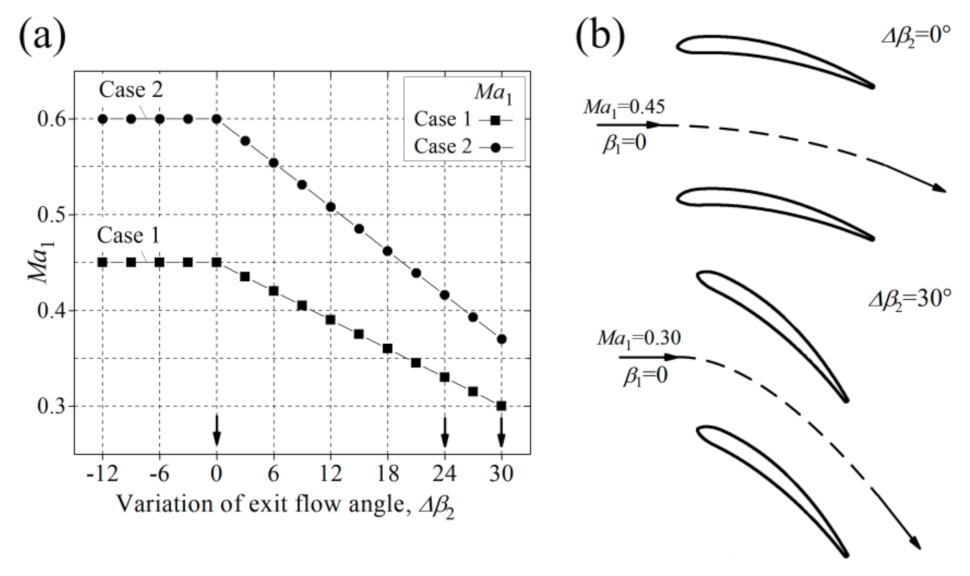
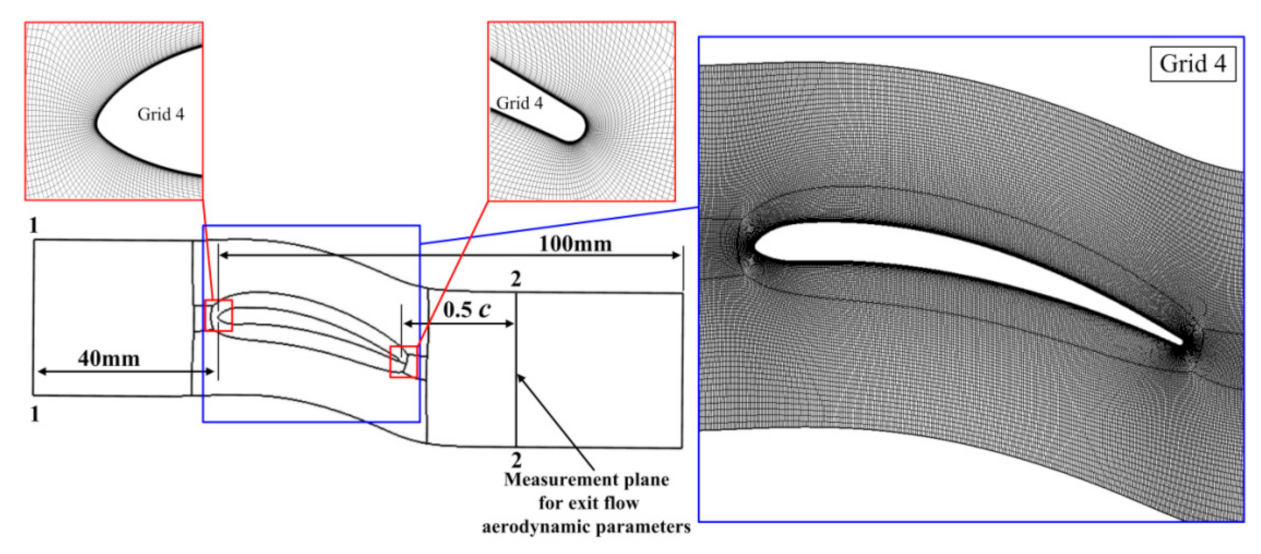

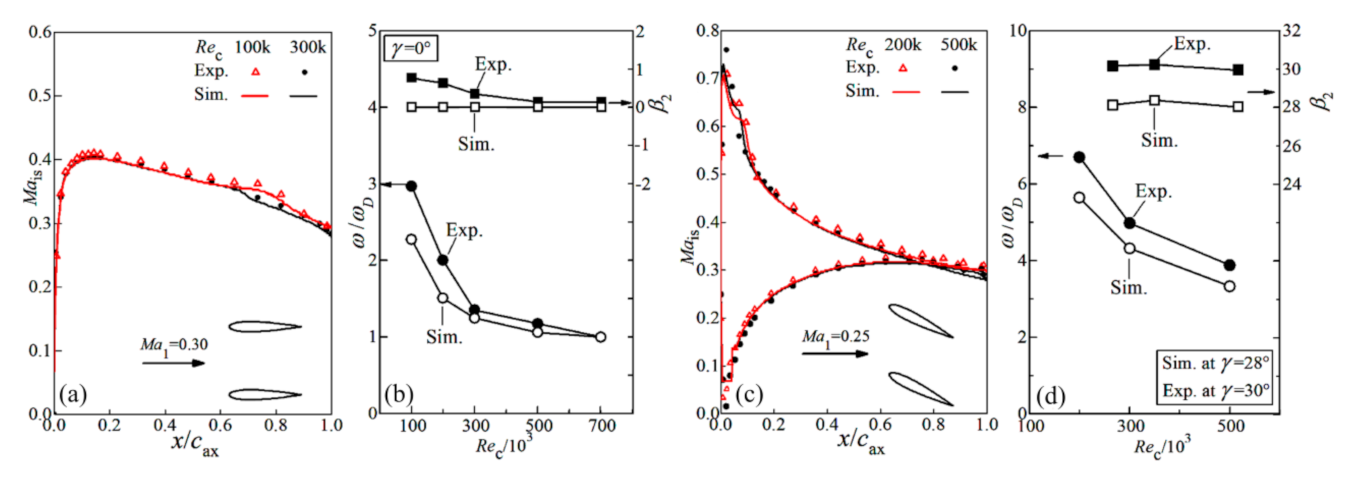

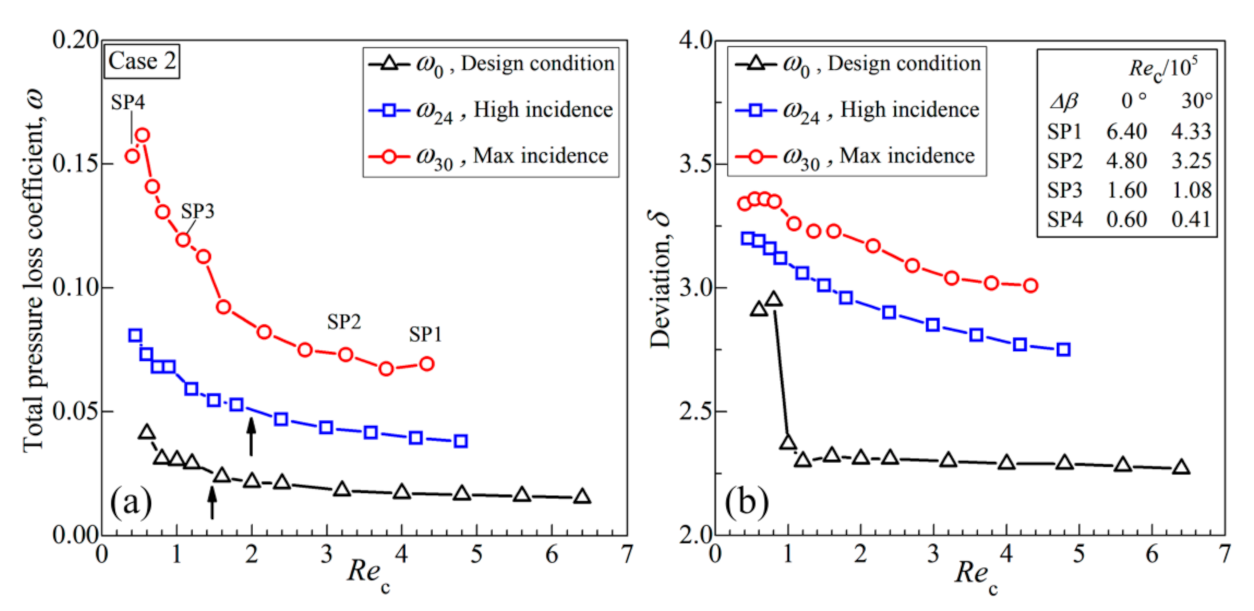


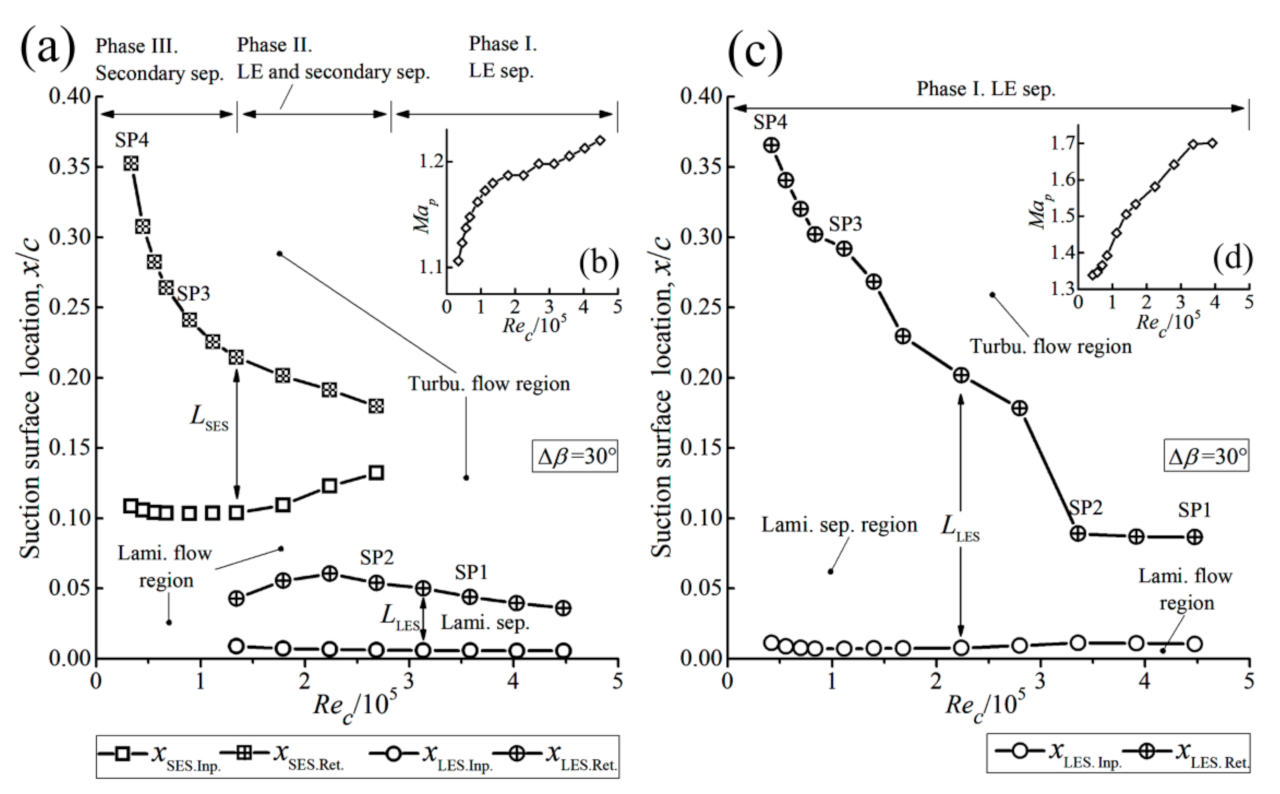






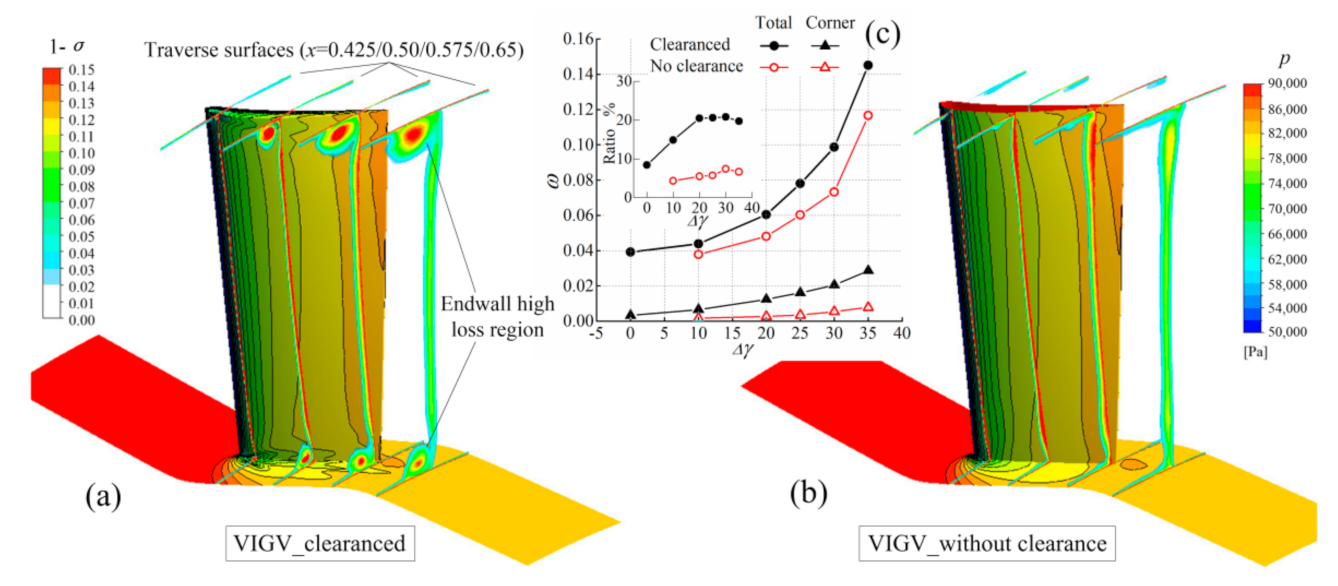
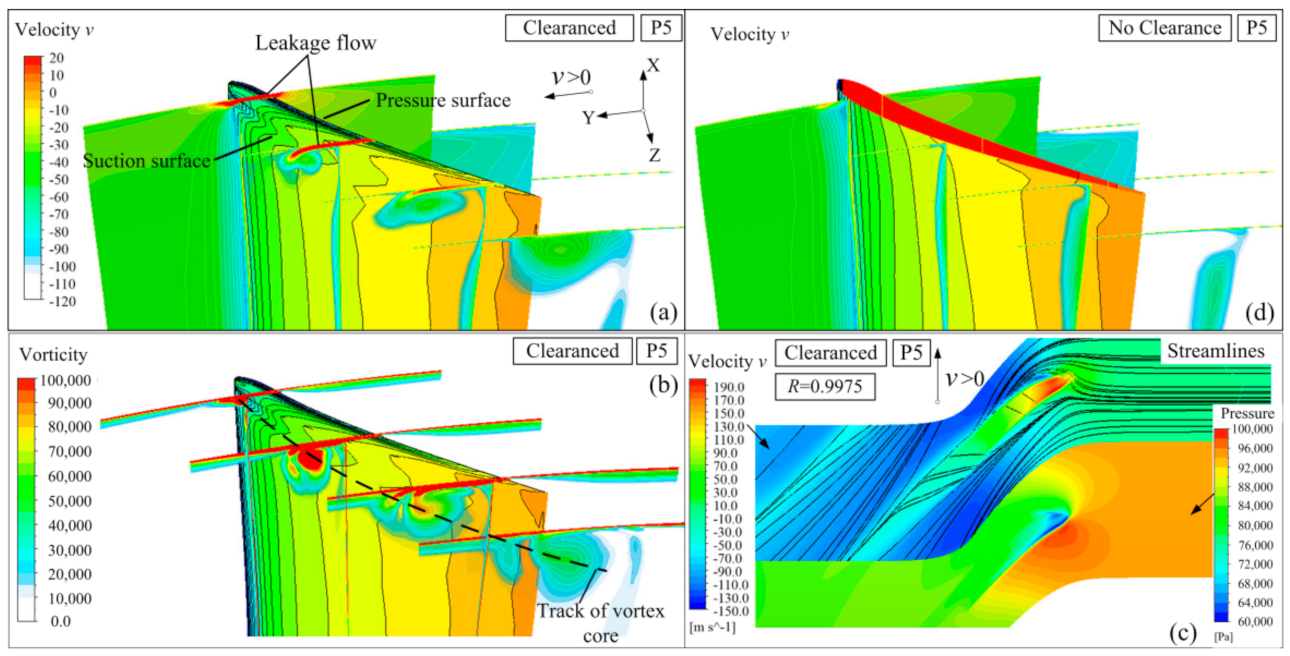
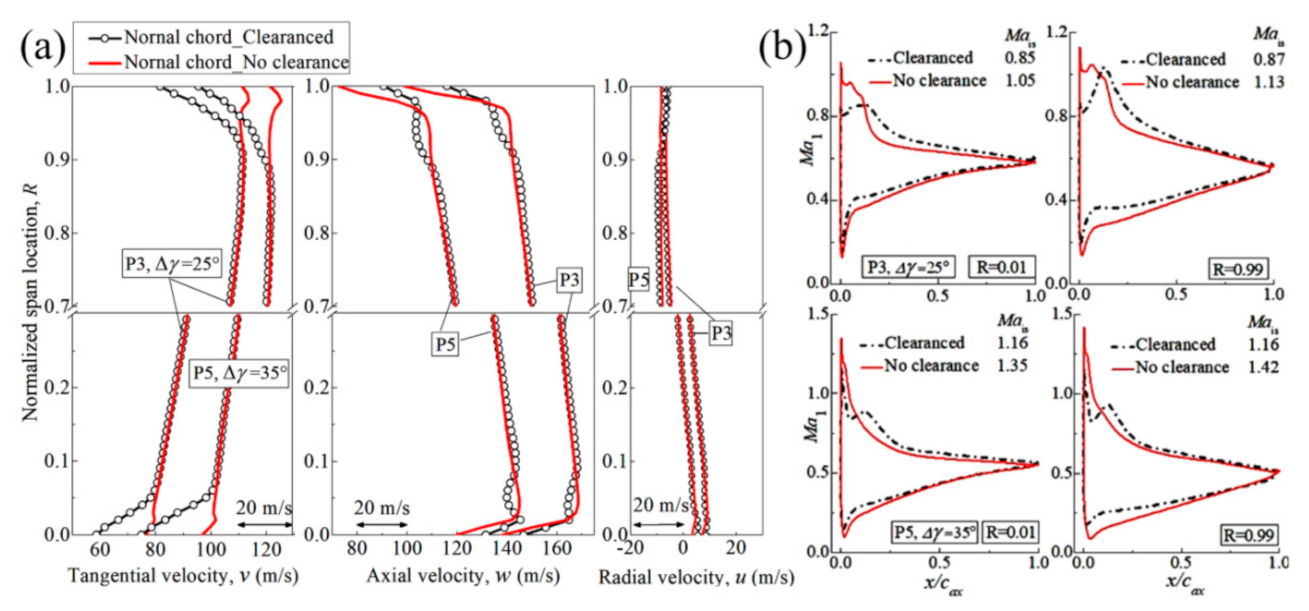
| Parameters | Case 1 | Case 2 |
|---|---|---|
| 0.45 | 0.60 | |
| 0 deg | ||
| 25.0 deg | 15.0 deg | |
| 1.20 | 1.05 | |
| 39.0 | 27.0 | |
| 0.08 | 0.09 | |
| 0.020 | 0.023 | |
| LE type | Curvature-continuous [5] with S= −0.1 | |
| Topology Parameter | Grid 1 | Grid 2 | Grid 3 | Grid 4 |
|---|---|---|---|---|
| Stream-wise nodes | 341 | 397 | 465 | 517 |
| Stream-wise nodes on profile surface | 81 | 121 | 181 | 225 |
| Pitch-wise nodes (around airfoil) | 66 | 106 | 146 | 178 |
| Pitch-wise nodes across the o-block | 21 | 33 | 45 | 53 |
| Nodes number of overall mesh | 85.0 k | 164.2 k | 261.2 k | 374.5 k |
| Operating Point | P1 | P2 | P3 | P4 | P5 |
|---|---|---|---|---|---|
| 0 deg | |||||
| 0 deg | 10 deg | 20 deg | 30 deg | 35 deg | |
Publisher’s Note: MDPI stays neutral with regard to jurisdictional claims in published maps and institutional affiliations. |
© 2021 by the author. Licensee MDPI, Basel, Switzerland. This article is an open access article distributed under the terms and conditions of the Creative Commons Attribution (CC BY) license (https://creativecommons.org/licenses/by/4.0/).
Share and Cite
Shi, H. Effect of the Reynolds Number and Clearance Flow on the Aerodynamic Characteristics of a New Variable Inlet Guide Vane. Aerospace 2021, 8, 172. https://doi.org/10.3390/aerospace8070172
Shi H. Effect of the Reynolds Number and Clearance Flow on the Aerodynamic Characteristics of a New Variable Inlet Guide Vane. Aerospace. 2021; 8(7):172. https://doi.org/10.3390/aerospace8070172
Chicago/Turabian StyleShi, Hengtao. 2021. "Effect of the Reynolds Number and Clearance Flow on the Aerodynamic Characteristics of a New Variable Inlet Guide Vane" Aerospace 8, no. 7: 172. https://doi.org/10.3390/aerospace8070172
APA StyleShi, H. (2021). Effect of the Reynolds Number and Clearance Flow on the Aerodynamic Characteristics of a New Variable Inlet Guide Vane. Aerospace, 8(7), 172. https://doi.org/10.3390/aerospace8070172






